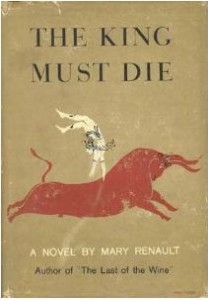As we progress through the step-by-step construction of a novel, I’d like to pause here and revisit the basic building blocks of a pageturner novel: action scenes and reaction scenes. In a previous post, we explored the basic structure of action/reaction scenes:
Action Scene:
- Hero strives to attain a goal
- Hero meets with conflict in his effort to achieve the goal
- Disaster: hero’s attempt to achieve his goal is frustrated
Reaction Scene:
- Hero reacts to the previous disaster (his emotions/feelings briefly explored/shown)
- Hero puzzles out how to again try for his goal
- Hero decides on an action course
Action scenes, always more interesting, are longer; reaction scenes, shorter.
But one thing to keep in mind is that the Action/Reaction scenes are not always drawn in what an artist would call “hard edges.”
Example:
 In The King Must Die, Mary Renault’s 1958 bestseller about the mythical hero Theseus, Renault establishes that as a young boy, Theseus believes what his mother (who bore him out of wedlock) has told him – namely, that his father is the god Poseidon. She opens Chapter 2 with eight-year-old Theseus on one of his annual monthly visits to Poseidon’s temple, where he strives to make contact with the god he believes to be his father. (Goal)
In The King Must Die, Mary Renault’s 1958 bestseller about the mythical hero Theseus, Renault establishes that as a young boy, Theseus believes what his mother (who bore him out of wedlock) has told him – namely, that his father is the god Poseidon. She opens Chapter 2 with eight-year-old Theseus on one of his annual monthly visits to Poseidon’s temple, where he strives to make contact with the god he believes to be his father. (Goal)
Enter Simo, a boy pledged by his father to Poseidon’s service. Simo is a sadistic bully who mocks the notion that Theseus is of divine parentage. Simo disrespecfully shoves Theseus to the ground to underscore his point. Theseus responds by fighting with Simo. (Conflict)
Theseus wins the fight. But the doubts Simo has sewn in his mind cause Theseus to doubt himself – and the story of Poseidon being his father. (Disaster)
So, while Thesus wins the fistfight with Simo (a victory), he has not achieved his key goal: to assure himself that his origins are indeed honorable.
The Reaction scene shows how Theseus begins to compare himself with other boys born the same year he was.
Because he is slight in build, and believes Poseidon’s son should be tall and sturdy, he decides to compensate by being more daring than the others. His immediate goal now is to outdo the other boys to prove himself. This sets up the next action scene.
In the next action scene, Theseus returns to Poseidon’s temple and is again confronted by the slow-to-learn Simo about his parentage. This time, Theseus stamps his foot in anger and, just then, an earthquake shakes the temple compound. This overwhelms Simo who now believes in Theseus’s divine origins. (Conflict)
So the chapter ends with Theseus’s victory over Simo.
Does this fly in the face of what we’ve talked about – that an action scene needs to end in a disaster?
Not at all. While Theseus has triumphed over a bully in the earthquake scene, he has still not achieved his key goal: to once and for all prove to himself and to others that his father is divine.
We know, from Theseus’s earlier eagerness to exhibit his god-like origins (bravery, daring, and physical prowess), that the victory over Simo does not constitute the achievement of Theseus’s key story goal. Simo is a brutish bully. The victory over such an adversary carries little by the way of glory, which is Theseus’s true goal. Nor does convincing one person ensure Theseus that the story of his divine origins will be universally accepted.
Theseus has won another little victory in the earthquake scene. He has achieved a short-term goal. But his main goal as yet eludes him.
Renault underscores this in the next chapter which takes place four years later and has Theseus observing that people have already forgotten about the foot-stamping/earthquake incident. Once again, his origins are being questioned, and more than ever he yearns to prove himself.
So action scenes can end in a small victories, so long as the hero remains frustrated insofar as his key goal is concerned. That, after all, is what maintains the story tension – and keeps readers turning pages.
Happy writing!

No Comments